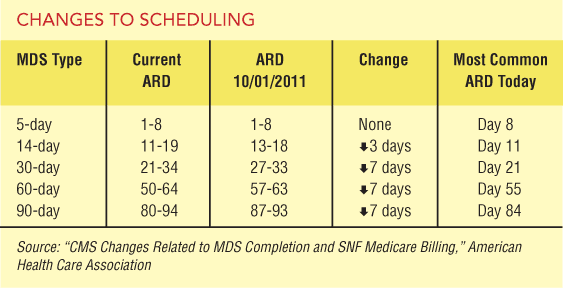One of the most visible ways CMS tweaked the assessment rule was to reduce the number of days available to complete each scheduled MDS and to cut the overlap of “look back” days between assessments. This impacts facilities’ basic MDS schedule and related software.
A closer look at the scheduling changes shows as an example that a patient undergoing a 14-day MDS assessment prior to the Oct. 1, 2011, revisions would have had an Assessment Reference Date (ARD) of between 11 and 19 days. Now, after the revisions by CMS, the ARD will be commonly done on day 11, a decline of three days, according to the Kindred webinar presentation for AHCA.
How Group Therapy Works
As for group therapy, the new rules say “group” must be scheduled for four patients performing the same or similar activities, not in the groupings of two or three that was a common practice before revisions went into effect.
CMS says the number four was chosen because groups larger than four are harder to manage effectively, while smaller groups limit the ability of patients to interact and learn collectively.
The revision assigns group minutes by dividing the minutes by four for allocation to the RUG regardless of group size. As an example, if a physical therapist conducts a 60-minute group session with four patients, each patient is credited 15 minutes of treatment toward their RUG level, CMS said.
This means that if only three people show up for therapy, each patient still gets 15 minutes of credit, Johnson says.
These changes in group minutes primarily affect RUG categories for Rehab Ultra High, Rehab Very High, and Rehab High.
Complexities Abound
Change of Therapy (COT) rules have also shifted. The new system requires the evaluation of rehabilitation service delivery seven days after ARD or COT to determine if the RUG has been maintained.
If the RUG is unchanged, no assessment is needed. If the RUG rehab intensity was increased, the COT Other Medicare Required Assessment (OMRA) must document an increase in the RUG, but if there is a decrease, COT OMRA must document a decrease in the RUG.

OMRA simply refers to an unscheduled assessment, like one to reclassify a resident from one rehab RUG level to another. Typically, an MDS nurse will make these reclassifications.
There are also changes for providers to grapple with in the area of End of Therapy (EOT) OMRAs, or unscheduled assessments, which are now required with three missed days of rehabilitation.
“This is regardless if a missed session is on a weekday, weekend, or holiday. Regardless of weekend coverage at the center. Regardless of why session was missed. Medicare does not recognize holidays as an acceptable day of missed therapy,” the Kindred presentation said.
There are other particulars for EOT OMRA covering EOT resumption and transition, but for Thompson and Johnson the most complex part of the changes is the work it takes to combine all of the assessments into a coherent MDS.
“When combining assessments, we must meet the requirements for all of the assessments,” they say. This includes the scheduled assessments, the Start of Therapy, EOT, and COT OMRAs.
“The complexity is that an MDS nurse or coordinator has to make sure to meet all the CMS rules for all types of assessments contained in the MDS and payment rules and any overlap,” Johnson says.
How To Tackle The Work
The experiences of Thompson and Johnson include that MDS nurses tend to complete assessments early in the window allowed to gauge a resident’s status. For example, if an assessment on a resident is due between the 27th and 33rd day of their stay, the nurse likely does the assessment on the 27th day. This can result in inefficiencies if the resident is discharged before the window expires, like on the 30th day.
This situation usually comes because of a lack of communication, the Kindred presentation said.
The nursing facilities that have the most problems navigating the MDS process include those with longer lengths of stay, decreased ability to provide weekend coverage, rehab staffing challenges, problems with scheduling rehab treatments, high patient refusals, poor communication, and poor management of activities of daily living (ADLs).
Strategies to win the battle with the MDS system and the new tweaks made over the past year are based mainly on better communication, Thompson and Johnson said, along with monitoring of ADL documentation, improving weekend coverage and patient scheduling, taking time for daily discussion of missed sessions, and planning how to make up missed sessions.
The questions on how best to use MDS and what the revisions by CMS mean for the coming year continued up to the Oct. 1, 2011, revisions date. In fact, because of the need for clarifications to the revisions gathered during CMS-conducted provider training calls in late summer, a number of late answers came about on the 2012 changes.
Among the CMS clarifications was that “intensity of therapy” now includes all qualifiers for a given therapy category, like days of therapy, therapy disciplines, restorative nursing programs, and other measures.

Another area in need of further CMS comment is the idea of what is a “Medicare week.” CMS said the seven-day look-back period used for a COT observation period is based on the ARD of the patient’s other assessments, not on a standard, weekly schedule.
More answers will come to other questions from the provider community as CMS continues to update, revise, and clarify what makes resident assessments correct and valuable tools in the care system for the nation’s skilled nursing facilities.